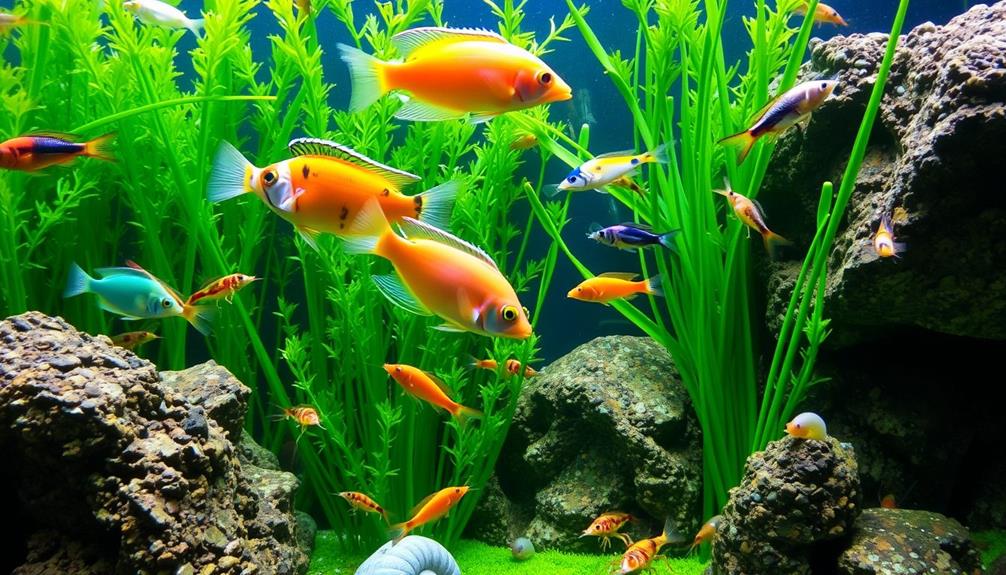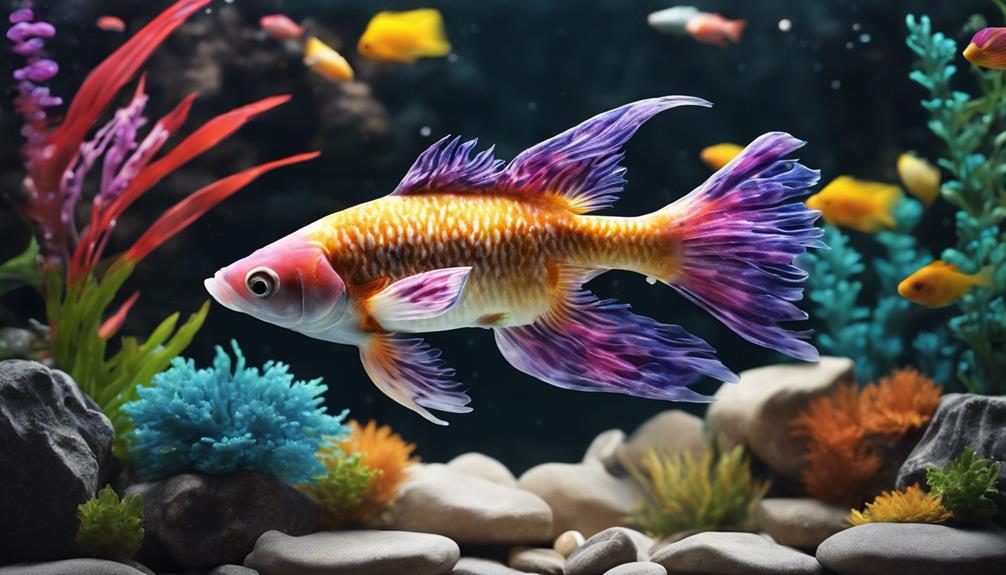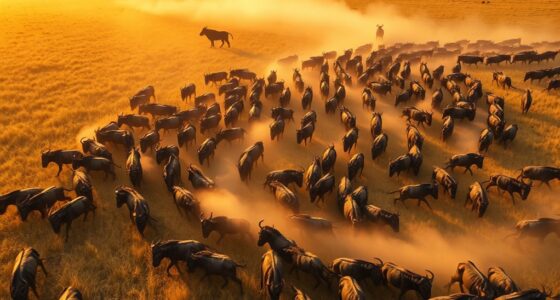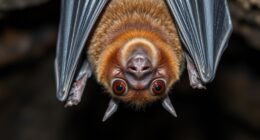If you want to keep your aquarium clean, consider adding some fantastic clean-up fish. Bristlenose Plecos and Siamese Algae Eaters are top choices; they eat algae and help maintain water quality. Otocinclus Catfish are small, peaceful grazers perfect for a community tank. For extra cleaning power, add Nerite Snails, which excel at algae control on glass. These species not only enhance cleanliness but also support a balanced environment. Make sure to choose compatible tank mates for a harmonious setup. Interested in finding out more about the best tank companions and maintenance tips?
Key Takeaways
- Clean-up crew fish like Bristlenose Plecos and Siamese Algae Eaters effectively control algae growth and improve water quality.
- Otocinclus Catfish are small, peaceful fish that thrive in groups and are ideal for maintaining cleanliness in smaller tanks.
- Nerite Snails are low-maintenance and excel at cleaning glass surfaces, contributing to overall tank hygiene.
- Regular water changes and monitoring water parameters are essential for maintaining a healthy environment for clean-up fish.
- Compatibility with other fish is crucial; choose peaceful tank mates to prevent territorial behavior and stress.
Overview of Clean-Up Crew
When it comes to maintaining a clean aquarium, having a well-chosen clean-up crew is vital. These members, including algae-eating fish and invertebrates, play a significant role in controlling fish tank algae, which can quickly become a problem.
By introducing species like Rainbow Sharks, Bristlenose Plecos, or Siamese Algae Eaters, you can effectively reduce algae growth and improve water quality. Additionally, confirming that your aquarium setup includes elements like brewing techniques can further enhance the overall health of your aquatic environment.
Moreover, Eartheaters such as Geophagus help by sifting through the substrate, promoting nutrient absorption for your plants in larger community tanks.
Snails, like Nerite and Malaysian trumpet snails, are also ideal choices, as they consume fish waste and organic debris, contributing to a cleaner environment.
It's important to take tank size and compatibility into account when selecting your clean-up crew. Each species has specific dietary needs, so verify they receive a varied diet to prevent malnutrition.
Top Clean-Up Fish Species

When it comes to keeping your tank clean, choosing the right algae-eating fish is essential.
You'll want species that not only control algae effectively but also get along with your other fish.
Plus, considering their dietary needs will help guarantee a thriving and balanced aquarium environment.
Incorporating stress management techniques for your aquatic pets can further enhance their well-being, as a balanced environment contributes to both the fish's health and the cleanliness of the tank.
Regular monitoring of water quality will also play a significant role in maintaining a healthy habitat for your fish.
Effective Algae Control Fish
Maintaining a clean aquarium can be a challenge, but adding effective algae control fish can make a significant difference. Here are some top species to evaluate for your freshwater aquarium:
| Fish Species | Key Features |
|---|---|
| Bristlenose Plecos | Excellent for green spot algae; 5-6 inches; 29-gallon minimum tank size. |
| Siamese Algae Eaters | Effective against green and brown algae; 6 inches; needs 30-gallon tank. |
| Otocinclus Catfish | Small (1-2 inches) and peaceful; thrives in groups; ideal for 10-gallon tanks. |
| Nerite Snails | Low-maintenance; great for cleaning glass; 3 cm; adds aesthetic value. |
Incorporating Bristlenose Plecos will help tackle stubborn algae like diatoms, while Siamese Algae Eaters are perfect for combating both green and brown types. If you prefer smaller fish, Otocinclus Catfish are fantastic for soft green algae. Don't overlook Nerite Snails, as they provide excellent algae control without much fuss. However, be cautious with Chinese Algae Eaters; while they consume filamentous algae, their growth up to 10 inches can lead to aggression with other tank mates. Choose wisely to maintain a harmonious and clean aquarium!
Peaceful Tank Companions
In a well-balanced aquarium, peaceful tank companions play an essential role in keeping your environment clean and harmonious. Corydoras are excellent foragers that use their barbels to sift through the substrate, making them perfect for community tanks. These small scavengers thrive in groups, ensuring they're always busy cleaning up any leftover food.
Additionally, you can consider tough dog names to give your aquatic friends a unique identity that reflects their hardy nature.
Bristlenose Plecos, with their unique bristle-like snouts, are hardy algae eaters that can tackle various types of algae in your freshwater aquarium. Growing up to 5 inches, they require a minimum 29-gallon tank to thrive.
If you have a smaller tank, consider Otocinclus Catfish. These small, non-aggressive fish max out at 1-2 inches and work best in groups, primarily feeding on soft green algae.
Don't overlook Amano Shrimp; they're highly effective scavengers that excel in cleaning up algae, especially in planted aquascapes. They can adapt to various tank sizes but need minerals for healthy molting.
Together, these peaceful tank companions create a dynamic ecosystem, keeping your aquarium clean while adding charm and activity.
Dietary Needs Considerations
Understanding the dietary needs of top clean-up fish species is vital for maintaining a healthy aquarium. For instance, Bristlenose Plecos require a varied diet that includes algae wafers, driftwood, and vegetables to thrive while keeping your tank clean.
Cats, similarly, have specific dietary requirements that must be met for peak health, as highlighted in the Cat Health and Nutrition section.
Otocinclus Catfish, which thrive in groups, primarily feed on soft green algae but also need supplemental foods like algae wafers to promote their health.
Siamese Algae Eaters have a hearty appetite for both algae and leftover food, so it's important to provide them with a balanced diet of herbivorous and protein-based foods to prevent territorial issues.
Amano Shrimp are scavengers that not only consume algae but also decaying matter. They need a diet rich in minerals, which can come from specialized shrimp food and blanched vegetables, to support healthy molting.
Chinese Algae Eaters primarily eat filamentous algae but can grow large and become aggressive as they age. To keep them well-fed and less territorial, guarantee their diet includes both algae and protein sources.
Benefits of Clean-Up Fish

Clean-up fish play an essential role in keeping your aquarium environment healthy and thriving. They actively scavenge leftover food and detritus, ensuring you maintain ideal water quality. By incorporating clean-up fish into your aquatic clean-up crew, you can greatly reduce the amount of debris in your tank.
Here's a quick overview of the benefits:
| Type of Clean-Up Fish | Primary Function | Benefits to Aquarium |
|---|---|---|
| Bristlenose Plecos | Scavenge leftover food | Improves water quality |
| Siamese Algae Eaters | Algae eating | Reduces unsightly growth |
| Amano Shrimp | Nutrient cycling | Enhances plant growth |
| Nerite Snails | Algae control | Prevents oxygen depletion |
These species consume various types of algae, providing benefits of algae while preventing issues like oxygen depletion. Their presence can also reduce the need for chemical treatments, promoting a more natural ecosystem. Just remember to monitor their population based on your tank size to prevent overpopulation and maintain a balanced environment.
Compatibility With Other Fish
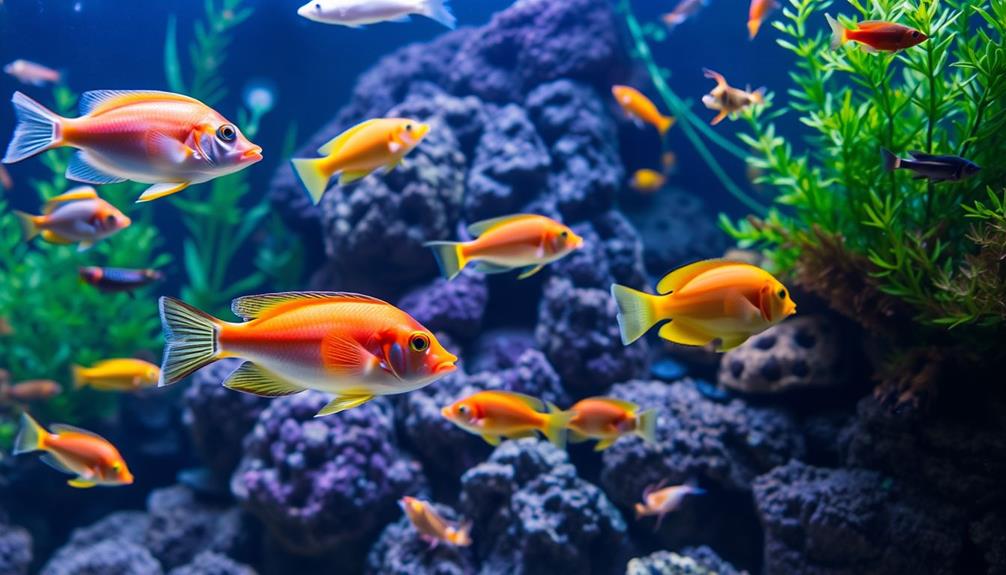
When adding algae-eating fish to your tank, you need to think about their compatibility with other species.
Some, like Bristlenose Plecos, are peaceful and fit well in community setups, while others, like the Chinese Algae Eater, can become territorial.
Play encourages exploration and understanding of their surroundings, which can help gauge how new fish may interact in the tank.
Plus, remember that tank size plays a big role in keeping everyone happy and reducing stress.
Peaceful Species Compatibility
Finding the right tank mates for your algae-eating fish is essential for maintaining a harmonious aquarium environment. When you choose peaceful community fish, you reduce the risk of territorial conflicts that can disrupt your clean-up crew.
For example, Bristlenose Plecos thrive alongside non-aggressive species like tetras and guppies, making them great companions. Incorporating natural materials and textures into your aquarium setup, much like in modern farmhouse decor trends, can also enhance the overall look and feel of your tank.
Otocinclus Catfish are also best kept with peaceful fish, as they're small and vulnerable. Ideal tank mates include rasboras and peaceful cichlids, which help create a safe space for your algae eaters.
Similarly, Siamese Algae Eaters can coexist with various tank mates, but it's wise to pair them with fast-moving fish like danios to minimize territorial issues as they mature.
If you're considering the American Flagfish, remember they do best in larger tanks with similarly sized peaceful fish to reduce aggressive behavior.
Finally, Nerite Snails can enhance your tank's cleanliness but should be kept away from larger fish that might see them as a snack.
Territorial Behavior Considerations
Territorial behavior can greatly impact the dynamics of your aquarium, especially when housing various fish species together. Some fish, like Rainbow Sharks and Redtail Sharks, are known for their aggressive behavior and need larger tanks—at least 29 gallons—to establish their territory.
In a similar vein, RV living for preppers emphasizes the significance of space and resource management, which can be reflected in how fish establish their territories. If you're considering adding algae-eating fish to your clean-up crew, keep in mind that the Siamese Algae Eater can become territorial as it matures, hence requiring a minimum of 30 gallons for one fish and 55 gallons for a group.
While Eartheaters are generally peaceful, they can display territorial behavior over substrate areas in larger community tanks. This means selecting compatible tank mates is essential to maintaining harmony.
Similarly, shy species like the Kuhli Loach prefer to hide and can be intimidated by aggressive fish, particularly in smaller tanks.
When introducing snails, such as Nerite Snails, you should also consider compatibility, as they can be vulnerable to predation from larger, more territorial fish. Balancing territorial behavior with peaceful species is important for a thriving aquarium.
Tank Size Requirements
Choosing the right tank size is essential for guaranteeing compatibility among your aquarium fish. A well-maintained aquarium can mimic natural ecosystems, promoting fish health and reducing stress.
If you want to maintain a harmonious environment, consider the following guidelines:
- Bristlenose Plecos need at least 60 liters. They're peaceful and can coexist with various community fish.
- Otocinclus Catfish thrive in groups and require a minimum of 40 liters. This size helps maintain stable water conditions for smaller community tanks.
- Siamese Algae Eaters grow up to 6 inches and should be kept in tanks of at least 30 gallons for one, with 55 gallons recommended for groups to guarantee compatibility.
Additionally, American Flagfish prefer tanks of at least 70 liters to thrive in groups with other small, non-aggressive fish.
Nerite Snails are versatile and adapt well to various tank sizes, but they do best in peaceful environments with stable water conditions.
Understanding the ecosystem dynamics can greatly enhance your aquarium experience and guarantee a successful setup.
For more information on sustainable practices in aquaculture, consider exploring eco-friendly energy sources.
Feeding and Care Requirements
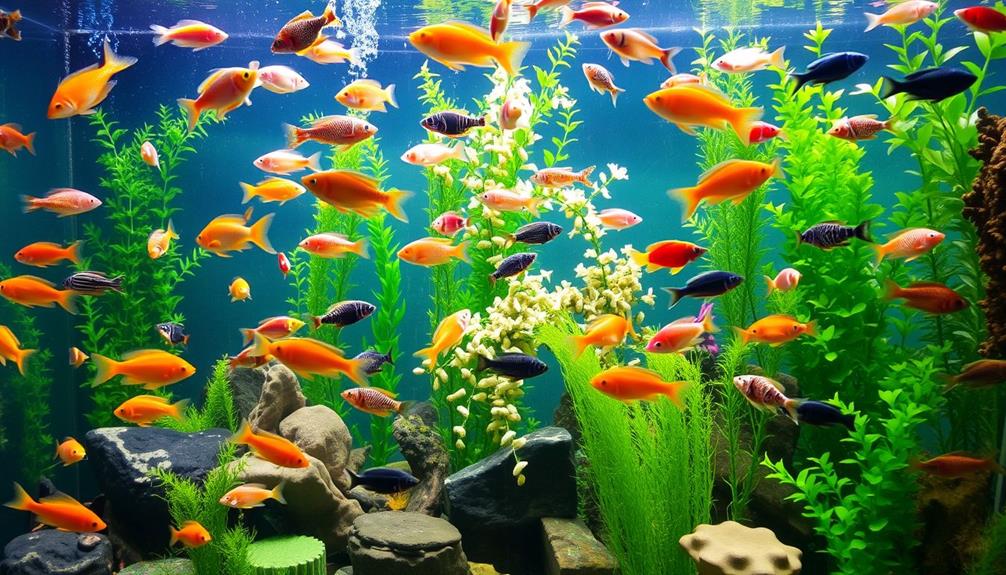
When it comes to keeping your aquarium fish healthy and thriving, understanding their feeding and care requirements is crucial. Adopting a healthy lifestyle can also apply to maintaining your aquarium, as a clean and well-balanced environment contributes to the overall well-being of your aquatic pets.
For example, Bristlenose Plecos need a varied diet that includes algae wafers, vegetables, and driftwood to stay in peak health. Make sure your tank is at least 60 liters with stable pH levels between 6.0 and 8.0, and temperatures between 25-28°C.
Otocinclus Catfish thrive best in groups and require stable water conditions with a pH of 6.9-7.2 and temperatures around 23-26°C. They primarily consume algae but should be supplemented with algae wafers for balanced nutrition.
Siamese Algae Eaters need a minimum tank size of 30 gallons and benefit from a diet of both algae and meaty foods.
Amano Shrimp are hardy scavengers that need minerals in the water for healthy molting and should be fed a varied diet of algae and specialized shrimp food.
Finally, Nerite Snails are low-maintenance algae eaters that thrive in a pH range of 7.0-8.0 and temperatures between 23-28°C but require supplemental food to meet their dietary needs.
Proper care guarantees your fish and shrimp keep your tank clean and vibrant!
Algae Control Strategies

Algae control is essential for maintaining a healthy aquarium environment, and there are several effective strategies you can implement.
For those interested in sustainable practices, incorporating edible vs. inedible plants in your aquarium can also play a role in managing algae growth.
Here are three key approaches to keep your tank clean:
- Introduce algae-eating fish: Species like Siamese Algae Eaters and Otocinclus Catfish actively graze on algae, helping to reduce its presence. Remember, Otocinclus thrive best in groups of six or more in tanks of at least 10 gallons.
- Prioritize water quality maintenance: Regularly monitor nitrate levels and limit light exposure to 8-12 hours daily. This helps prevent excessive algae growth while promoting a balanced aquarium ecosystem.
- Enhance your tank with live plants: Adding live plants competes for nutrients with algae, limiting its growth and improving your aquarium's aesthetics.
Additionally, consider using Tetra Algumin Algae Treatment to effectively target various algae types while remaining safe for your fish and plants.
Don't forget manual removal techniques like algae scrubbers or siphon cleaners; these can provide immediate results.
Maintenance Best Practices
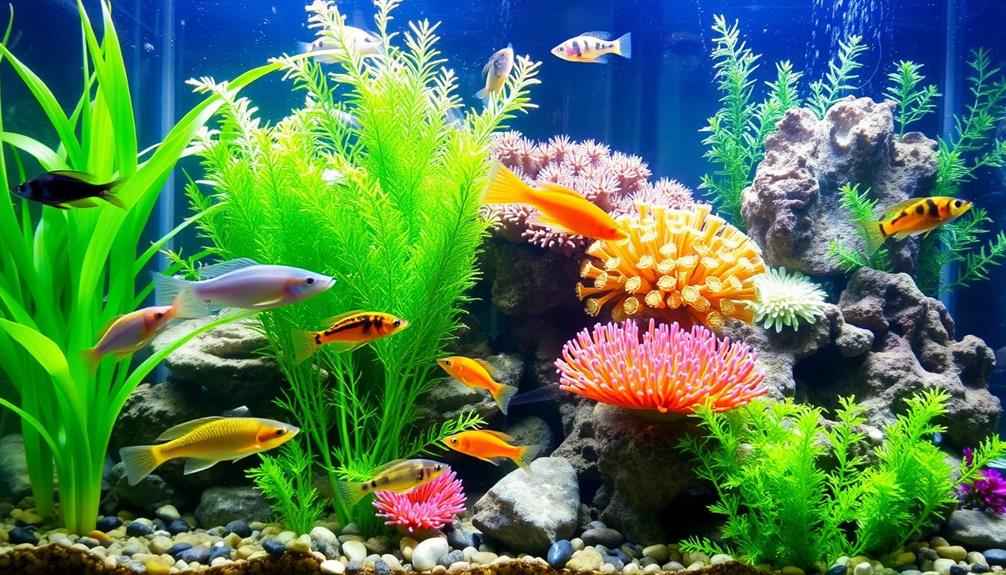
Maintaining a clean and healthy aquarium requires consistent attention to various best practices that promote water quality and fish well-being.
Start by performing regular water changes of 10-15% each week. This helps dilute harmful substances and keeps your aquatic environment ideal for both your fish and the clean-up crew.
Next, you should be testing your water parameters, including pH, nitrates, and ammonia levels, bi-weekly. This guarantees you catch any potential spikes that could harm your fish.
Don't forget to clean your substrate using an aquarium siphon every 2-4 weeks to remove uneaten fish food and waste, which can cause algae issues in your tank.
Implement a consistent lighting schedule of 8-12 hours daily to prevent excessive algae growth while allowing your plants to photosynthesize properly.
Finally, regularly monitoring and adjusting your feeding practices is essential. Overfeeding can lead to nutrient buildup, which contributes to algae in your tank.
Selecting the Right Fish
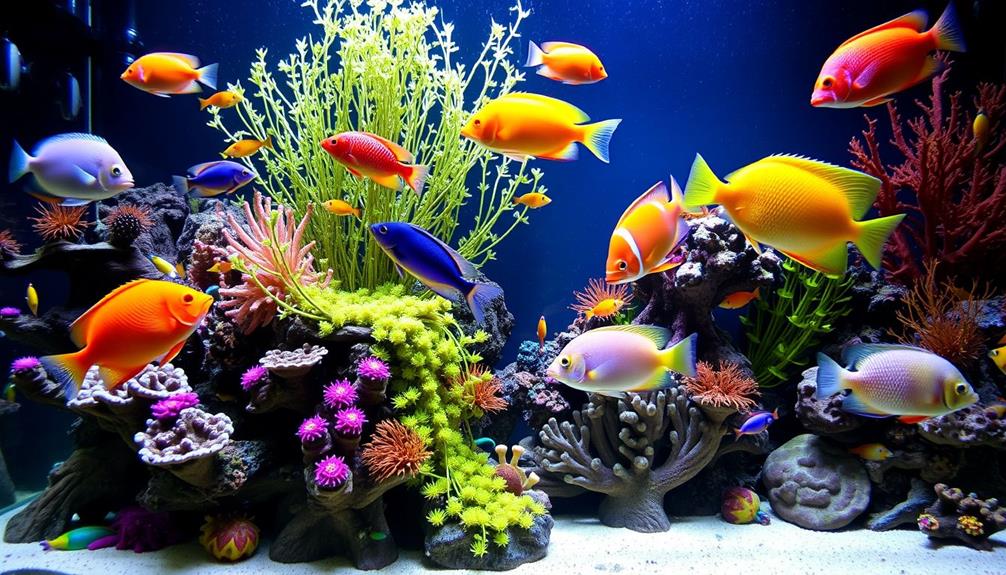
Choosing the right fish for your aquarium involves careful consideration of both their algae-eating habits and compatibility with existing tank mates.
To create an effective clean-up crew, follow these three guidelines:
- Research Algae Types: Identify the specific algae types in your tank. Some algae-eating fish, like Siamese Algae Eaters, excel at consuming green and brown algae, while others may prefer different varieties.
- Check Compatibility: Verify the selected fish are compatible with your current tank inhabitants. For instance, while Bristlenose Plecos and Otocinclus Catfish are peaceful additions, Chinese Algae Eaters can become aggressive as they mature, potentially disrupting tank harmony.
- Maintain Proper Conditions: Pay attention to water temperature and pH levels, tailored to your chosen algae-eating fish. For example, Otocinclus thrive in temperatures between 22-26°C and a pH of 6.8-7.5.
Lastly, remember to supplement their diets with high-quality fish foods.
Relying solely on algae can lead to malnutrition, so feeding them algae wafers can promote their health and longevity.
Frequently Asked Questions
What Fish Keeps a Fish Tank Clean?
When considering how to keep your fish tank clean, think about specific fish that thrive on algae and detritus. Options like Bristlenose Plecos and Siamese Algae Eaters are effective and beneficial for tank health.
What Will Help Keep My Fish Tank Clean?
To keep your fish tank clean, regularly perform water changes, use a quality filter, and maintain proper feeding schedules. You'll also want to monitor water parameters and include cleaning crew members for ideal cleanliness.
What Aquarium Fish Cleans Water?
Ever wonder how to keep your water crystal clear? While no fish directly cleans water, some fish and snails help reduce waste and algae, improving overall tank health and clarity. Your tank will thrive!
What Fish Do Cleaner Fish Clean?
Cleaner fish, like the Cleaner Wrasse and Neon Goby, typically clean larger fish. They remove parasites and dead skin, ensuring the health of their hosts while gaining protection and food in return. It's a mutual relationship.
Conclusion
Incorporating clean-up fish into your aquarium not only enhances its beauty but also helps maintain a healthy environment. Did you know that a single algae-eating fish can consume up to 50% of its body weight in algae daily? This impressive statistic highlights their efficiency in keeping your tank clean. By selecting the right species and ensuring compatibility, you'll enjoy a thriving aquatic ecosystem while minimizing maintenance. Immerse yourself and discover the benefits of these remarkable fish!
